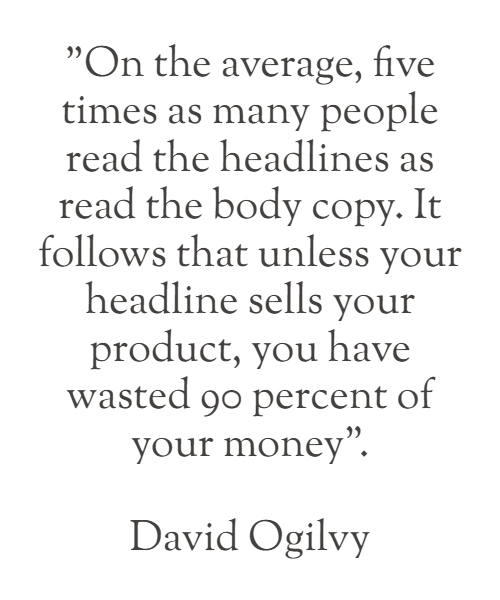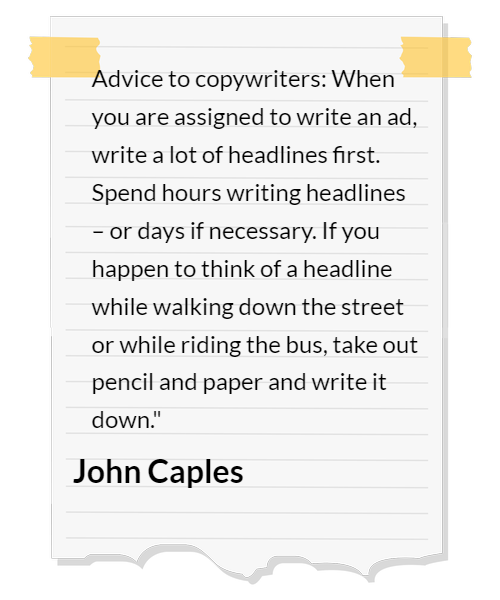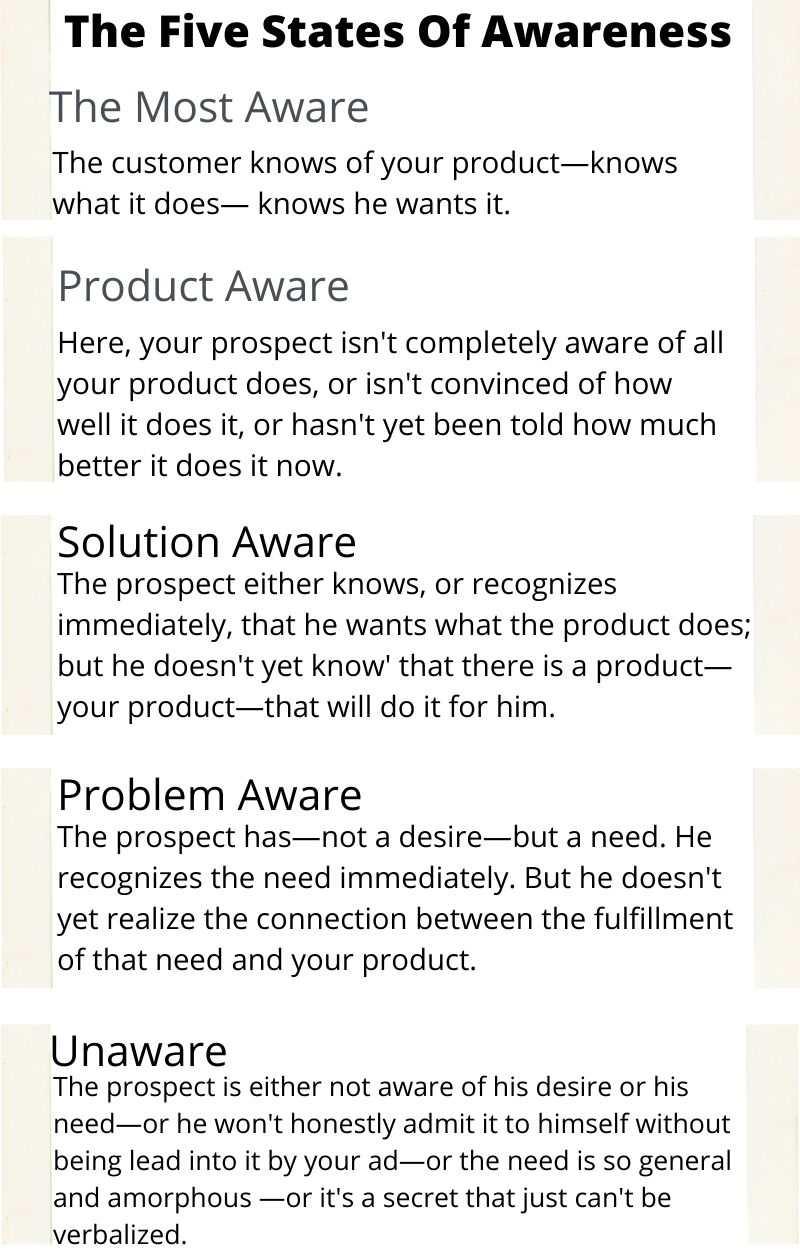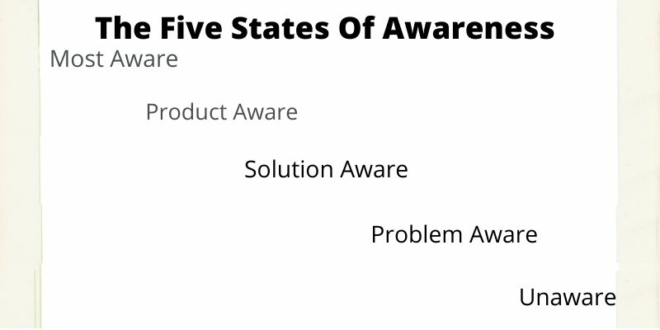Your headline is an essential part of your ad. That is why you should spend 80% of your time on your headline and 20% of the rest of your ad. No one will read the rest of your copy if you don’t capture them with your headline. And it needs to be written according to your prospect’s states of awareness.
In case you have any doubt about the importance of headlines, here is what some of the greats in advertising have to say


Your headline, according to Eugene Schwartz (Breakthrough Advertising), has only one job – to get the attention of your prospect and convince him to read the first sentence of your ad. But, just like your first sentence has just one task, your second sentence has only one purpose: it must compel your prospect to read the third sentence of your advertisement. And the third sentence—as well as every other sentence in your advertising—has exactly the same purpose.
How you can start with your headline depends on the answers to these questions:
1. What is the mass desire that creates this market?
When you’ve found out the mass desire, you’ll know what your target audience wants and what you need to offer in your copy.
2. How much do these people know today about the way your product satisfies this desire? (Their State of Awareness.)
To figure out how you will promote it, you must first know the awareness state of the customer. The more aware your market is, the more direct your headline and message needs to be, and
3. How many other products have been presented to them before yours? (Their State of Sophistication).
And you have to write it according to your prospect’s states of awareness.
The Five States Of Awareness

1. The Most Aware
“The customer knows of your product—knows what it does— knows he wants it”.
In this state of awareness, customers know your product and know it can solve their problems. They need some trigger to buy it. It can be a discount, bonus, coupon, urgency, free shipping, bundled package, or something else. Start your research and see how your competition offers a similar product. And offer something better.
So consider how to make your offer better than the one from your competition.
Offer bonuses and packages, which are valuable for them and with low cost for you.
Put reviews in your copy to convince readers your product is worth their money.
Also, you can just send them the email with the full price at this stage. Then, if they desperately need your product, they will pay the full price too.
2. Product Aware
“The Customer Knows of the Product But Doesn’t Yet Want It Here, your prospect isn’t completely aware of all your product does, or isn’t convinced of how well it does it, or hasn’t yet been told how much better it does it now…
…Here vour headline is faced with one of seven tasks:
(a) To reinforce your prospects desire for your product:
(b) To sharpen his image of the way vour product satisfies that desire;
(c) To extend his image of where and when vour product satisfies that desire;
(d) To introduce new proof, details, documentation of how well vour product satisfies that desire;
(e) To announce a new mechanism in that product to enable it to satisfy that desire e\-en better;
(f) To announce a new mechanism in vour product that eliminates former limitations;
(g) Or to completely change the image or the mechanism of that product, in order to remove it from the competition of other products claiming to satisfy the same desire. “
Your prospect knows about your product in this phase. With your copy, you need to convince the reader that your product is better than other similar products and the best solution for them. You need to convince the reader of the benefits and help with your copy.
So you need to provide testimonials, statistics, or other proof to persuade the customer to buy your product instead of the one from the competitors.
3. Solution Aware
“The prospect either knows, or recognizes immediately, that he wants what the product does; but he doesn’t yet know’ that there is a product—your product—that will do it for him…
…The three steps in the process are simple.
1)Name the desire and/or its solution in vour headline.
2)Prove that that solution can be accomplished.
3)And show that the mechanism of that accomplishment is contained in vour product.
However, starting with a market in this still-amorphous state of awareness, and continuing with each of the more difficult challenges to come, the execution becomes more and more important than the mechanics.”
Your prospect is aware he wants to relieve from their problems. But they don’t know that your product can provide that benefit and solve their problems. With your copy, you need to convince them that they found the solution to their problem by buying your product.
4. Problem Aware
“The prospect has—not a desire—but a need. He recognizes the need immediately. But he doesn’t yet realize the connection between the fulfillment of that need and your product. This is the problem-solving ad… Here you start by naming the need and/or its solution in your headline. Then dramatize the need so vividly that the prospect realizes just how badly he needs the solution. And then present your product as the inevitable solution”
Your task in this awareness stage is to focus on your prospect’s problem. Write more about the problem and the pain and make the prospect feel they found something to solve pains. Make them curious to click and see what you offer as a solution.
5. Unaware
“The prospect is either not aware of his desire or his need—or he won’t honestly admit it to himself without being lead into it by your ad—or the need is so general and amorphous that it resists being summed up in a single headline—or it’s a secret that just can’t be verbalized.”
As a result of the lack of recognition of a need, it is extremely difficult to sell in this state. You can’t provide a remedy for an issue that doesn’t exist.
It will be tough to sell to audiences unfamiliar with the product. So the best option for you is to capture their attention by ensuring that they identify with the headline copy – and then hold onto that attention for as long as you possibly can to raise their states of awareness.
To accomplish this, you must make the reader identify with the copy.
“What you are doing essentially in this fifth stage is calling your market together in the headline of your ad. You are writing an identification headline. You are selling nothing, promising nothing, satisfying nothing. Instead, you are echoing an emotion, an attitude, a satisfaction that picks people out from the crowd and binds them together in a single statement.”
Why do you need to pay attention to these states of awareness?
So if you create the copy to the most aware market and promote it to the customers who look for the solution to their problem, it will be a waste of time and money. They don’t know your product/service and how it can solve their problem.
Also, the campaign will fail if you create the copy for the solution-aware market and promote it to unaware prospects. Why? People are not aware of the need or desire at all, and they don’t need any solution at the moment.
So to conclude:
“The headline is the bridge between your prospect and your product. It touches your prospect at the point of awareness that he has arrived at today. If he is aware of your product, and realizes that it can satisfy his desire, your headline starts with your product. If he is not aware of your product, but only of the desire itself, your headline starts with the desire. And, if he is not yet aware of what he really seeks, but is concerned only with a general problem, your headline starts with that problem and crystallizes it into a specific need”.

